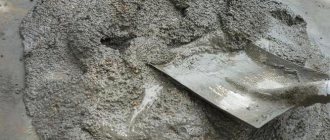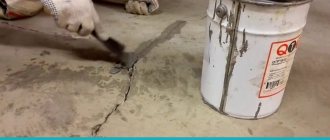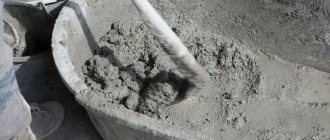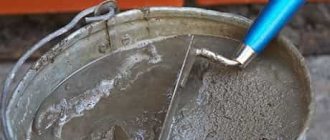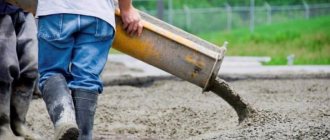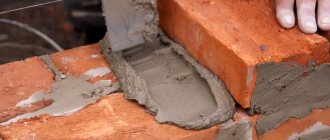Cement mortar is used almost everywhere in construction work. Concrete is made from it for repairs and construction of buildings, used for pouring foundations, and used for stone and brickwork. Knowing how to properly make such a solution with your own hands will help you carry out high-quality repair or construction work.
Stirring cement mortar Source i.ytimg.com
How to stir the composition
First, to obtain the mixture, you need to prepare a container in which stirring will be done.
This can be done in one of the following ways:
- The required amount of water is poured into the container. Then cement and sand are gradually added, while continuously stirring. If there is not enough water, it is added at the end of the procedure.
- With this method, bulk elements are first added: sand and cement. After this they need to be stirred. The resulting composition is diluted with the required amount of water to obtain a plastic mixture.
Before making the solution, you need to ensure that there are no large pieces there. For this purpose, they are pre-sifted. During the preparation of the mixture, it is important to ensure uniform stirring. This becomes especially important in cases where special additives are used.
It should be borne in mind that to obtain a high-quality mixture, it is necessary to add crushed stone or gravel as a filler.
For a high-quality solution you need to use river sand Source domstroiki.stroimdom.com.ua
Drying time
The hardening time of the cement mortar directly depends on the ambient temperature and the thickness of the coating. The thicker the screed layer and the lower the thermometer, the longer the mixture will take to dry.
Let's consider the hardening time under favorable conditions:
- 2–4 hours – setting of the solution;
- 12–24 hours – the cement has not completely hardened, you can walk on it, but finishing work is not recommended;
- 10–14 days – complete drying of the coating, after which you can begin finishing the surface with tiles or other materials.
The hardening conditions are easiest to observe indoors – when screeding floors, plastering and other finishing works. There are no temperature changes in the apartment, so the solution hardens evenly and quickly.
How to prepare cement at low temperature
The ideal temperature for pouring cement mortar is +200C and above. But such conditions are not always possible to create during the construction and exterior decoration of a building. At sub-zero temperatures, the concrete solution forms lumps, and the water in the composition turns into ice. This directly affects the quality of the coating.
In construction, there are several techniques that help avoid damage to the cement mixture at sub-zero temperatures:
- Special antifreeze additives in the composition;
- Heating water and sand when mixing concrete;
- Electric heating of the coating;
- Covering the fill with an awning and insulating the formwork.
For masonry at sub-zero temperatures (up to -7°C), you need to use cement mortar (in the ratio of cement to sand - 1:4) or cement-calcium (1:1:6 - cement, calcium, sand). The solution should be thickly plastic, that is, contain a small amount of water.
It is very difficult to make electric heating of concrete with your own hands. To do this, heated electrical cables are brought to the surface, which transfer heat to the concrete coating.
The easiest way to insulate the cement surface outdoors is with a stretched awning. This design will retain heat in light frosts.
Required ingredients and equipment
To prepare cement mortar you need to prepare:
- A container in which the mixture will be stirred. For this purpose, it is best to use a concrete mixer.
- You will need buckets, as well as a bayonet shovel.
- It is necessary to prepare a mixing drill equipped with a suitable attachment.
Equipment preparation depends on the expected scale of work. If we are talking about a large amount of work, then it would be better to use a concrete mixer to mix the components. For small, one-time work, you can use, for example, an old bathtub or tub.
The following ingredients will be required:
- The sand must be fine and not contain clumps or pieces of other material.
- The basis of the composition is Portland cement. It must be of the brand required according to the recipe.
- Additives must be prepared if they are to be used.
To prepare the solution you need to prepare everything you need Source strojka-gid.ru
- You will need enough water to obtain a plastic mixture.
If it is intended to create concrete, additional crushed stone or gravel will be required as a binding element.
Necessary materials and tools for work
Its strength, technical and visual characteristics depend on the composition of the cement solution. The standard composition of the mixture consists of three elements:
- dry cement;
- sand;
- water.
In order to change the qualities of the composition, the following additives are used:
- detergent;
- PVA glue;
- lime;
- dyes.
They affect the color of the coating and help make it more flexible and adhesive.
In order to mix and lay the cement mortar, you will need the following tools:
- a bucket or deep basin for stirring, corresponding in size to the volume of the mixture;
- construction mixer or drill with an attachment;
- spatula or spatula for spreading the mixture over the surface;
- gloves and glasses for safety purposes.
All these tools will probably be found in the households of people who have at least once done repairs. Otherwise, you should buy them or borrow them from friends.
A construction mixer or a drill attachment will help stir the mixture without lumps. The composition will be homogeneous and there will be no voids left in it after hardening.
For pouring wide surfaces, it is recommended to use a concrete mixer. It will significantly reduce the time of mixing the solution and help calculate proportions for a large volume of material.
Brand of solution
To create a composition, it is necessary to determine which brand is required. For each building element, a corresponding brand of mortar is provided. In accordance with it, it is determined what type of Portland cement should be used.
The following must be taken into account:
- If we are talking about brickwork, the grade of which is M100, then the mortar that needs to be prepared must be of the same grade.
- In the case where the walls are made of M300 grade brick, the required strength of the masonry is achieved by using the M150 grade of cement.
- If the cement mixture is prepared with the aim of using the mixture for interior decoration, then in this case the M50 or M100 brand would be a good choice.
The solution must be thoroughly mixed Source i.ytimg.com
- For foundations or concrete screeds, M200 is required.
It must be taken into account that the brand of the resulting mixture is determined by what Portland cement was used for its preparation. The best option is when the brands match in both cases.
Recipe in buckets
It is clear that in factory conditions, the components of concrete solutions enter the concrete mixer drum strictly in portions. And they are measured using automatic scales. That is, it is impossible to make a mistake with the recipe at the factory. Therefore, my advice is to purchase ready-mixed concrete and pour it into the foundation for your own house.
But what should those private developers do who do not have the opportunity to buy concrete at the factory? After all, they prepare solutions in portable or mobile concrete mixers. Weighing each portion of material on a scale is both time-consuming and tedious. That's why many people use buckets as a template for measuring quantities.
For example, a bucket of cement weighs 15 kg (± 0.5 kg), sand – 19 kg, medium crushed stone – 17.5 kg. Based on this, you can easily calculate what the ratio of sand and cement should be when pouring the foundation, of course, taking into account crushed stone.
As an example, we can give the recipe for the M200 concrete mixture used for the foundation per 1 m³. After all, concrete is taken in cubic meters. So for this volume you will need 2 buckets of cement, 5 buckets of sand and 9 crushed stone. But you will need 1 bucket of water.
Correct proportions of cement mortar
If the composition is prepared at home, you need to take into account that using the right brand of cement and maintaining the exact proportions will guarantee the good quality of the resulting solution.
The proportions of cement and sand for various options for using the solution are as follows:
- When creating M350 grade concrete, you need to take one part of cement, two of sand and four of gravel, crushed stone or other filler. Then add water, the amount of which should not exceed half the weight of Portland cement. The resulting mixture must be thoroughly mixed.
Stages of mortar preparation Source center-esm.ru
See also: Catalog of stone house projects presented at the “Low-Rise Country” exhibition.
- To prepare a cement-sand mortar for a brick screed, you can use M300 or M400 cement. In this case, three or four parts of sand are added to one part of cement. If you additionally take slaked lime in a volume of 20% of the mass of cement, the resulting composition will become more plastic.
- When treating wall surfaces (both internal and external) when preparing cement mortar, the proportions are as follows: one part cement and three parts fine sand. Water is added gradually, mixing thoroughly. This must be done until a plastic mixture is obtained.
- In order to make the screed, Portland cement brand M350 is used. In this case, a cement solution is made, the proportions of which are as follows: for one part of cement, take three parts of sand. If fine-grained expanded clay is added as a binding element, this will increase the thermal insulation properties of the cement composition.
You can mix concrete in an old bathroom Source pbs.twimg.com
When preparing and mixing the solution, you need to take into account that the higher the grade of cement used, the greater the amount of sand you will need to use. If you have no experience in preparing the solution, then it makes sense to think about purchasing a ready-made composition from third-party suppliers.
The use of concrete in home decoration
In the interior decoration of apartments and houses, concrete is used in three types of work:
- plastering walls;
- pouring floor screed;
- installation of ceramic tiles in the bathroom.
The solution for home finishing must be sufficiently plastic and have good adhesion to the rough coating. Therefore, plasticizers and adhesive additives must be added to it.
Ready-made adhesive is often used to lay tiles in the bathroom, but cement mortar is also well suited for these purposes. It is important to take care of the waterproofing of the floor and the presence of antifungal compounds in the finished mixture.
How to choose sand
It must be remembered that not just any sand is suitable for a high-quality solution. When selecting it, certain requirements must be met:
- The best option would be to use river sand of large or medium-sized fractions.
- It is recommended to sift before use to ensure that there are no clots or large foreign particles.
- It is more effective to use washed sand.
River sand particles have sharp edges. This feature allows you to avoid settling of sand in the mixture.
If the sand is washed, this will ensure that dust does not form from it. In this case, the strength of the cement will become higher.
Screed Source remontik.org
See also: Catalog of companies that specialize in the design and construction of turnkey country houses.
Component Specifications
So, having dealt with the question of what proportions of cement and sand are needed for pouring the foundation, it must be noted that the characteristics of the fillers and mixer are not the least important in the correct preparation of concrete.
Let's start with water. The process of mixing water with cement is called mixing. In order for the chemical reaction between the sealer and the binder to be successful, and the final result to meet the requirements, it is necessary to pour clean water into the solution without dirt and salt impurities.
As for sand, here too special requirements are imposed on its purity. After all, it always contains organic inclusions and clay additives. And the fewer there are, the better. In this case, the size of the grains of sand should not exceed 5 mm. It is believed that the optimal sand, which is used in the manufacture of concrete, is washed from the river. Quarry is a material that contains a lot of clay, which reduces the characteristics of solutions.
River washed sand is preferable to quarry sand Source pol-inform.ru
Crushed stone is the largest filler. It must also be clean. As for the sizes, or in other words fractions, here it is necessary to take into account the dimensions of the foundation itself. The larger the latter, the larger fraction of crushed stone can be used. But experts recommend mixing crushed stone of different fractions in order to fill the space between the stones as much as possible. This is how you can reduce cement consumption without compromising the quality of concrete.
It should be taken into account that the grade of coarse filler should be twice the grade of concrete.
Adding water
To prepare a high-quality cement mortar, not only the composition of the mixture is important, but also the addition of the required amount of water.
Depending on how you dilute cement with water, the following properties of the mixture may change:
- plasticity of the mixture;
- strength of the resulting solution;
- the speed at which the hardening will take place.
The required amount of water for the mixture ranges from 50 to 100 percent by weight of the Portland cement used. The exact volume is selected individually directly during the preparation of the mixture.
Useful tips
- Select a deep container for the solution so that when stirring it does not splash out over the walls;
- Instead of mortar, special grouts can be used to treat the seams of bricks or tiles; in this case, cement dyes will not be required;
- A day after screeding the floor, cover it with film so that the coating is not damaged during the repair process.
To prepare the mixture, it is recommended to use river or quarry sand. Due to the clay content in its composition, the solution will be more plastic and sticky.
Application of additives
When making cement mortar, not only standard components are important, but also additives. Typically the following substances can be used:
- Gravel or crushed stone is a filler that is added for strength.
- If you add liquid soap, the mixture will become more plastic.
- Use of micro-reinforcement.
- To increase frost resistance, plasticizers can be used.
Sand concrete with fiber Source stroy-okey.ru
- There are additives that reduce the period of time during which hardening occurs.
If you plan to use certain additives, it is recommended to use a proven recipe to determine how to dilute cement correctly.
When using plasticizers, concrete adheres better to complex surfaces. At the same time, it is easier to level and after drying a smoother surface is formed. However, such additives have a significant disadvantage: they are relatively expensive.
There is a way to create plasticizers yourself. You can use soap for this purpose. At the same time, the consumption is insignificant: one glass of liquid soap is required for a whole concrete mixer. Using this method, you need to ensure that the specified dosage is not exceeded. The soap solution not only increases plasticity, but also at the same time reduces the adhesion of the mixture to the sand particles included in it.
Fiber fiber for mortar reinforcement Source kak-sdelano.ru
Secret Chinese cement
Slaked lime is poorly soluble in water
The recipe for preparing the unique cement Chio Liao remained unknown for a long time. And this is despite its phenomenal versatility - it is suitable for gluing porcelain, earthenware, marble, leather, plaster and many other products. As it turns out, preparing it is very simple. Take 54 parts of slaked lime and mix with 6 parts of alum powder. Then add 40 parts of beaten fresh blood (chicken, calf or pig). The final mixture is stirred to a uniform consistency in the form of a dough. It is applied to the surfaces to be bonded.
In liquid form, the composition is applied like paint to surfaces that want to be protected from moisture and mechanical damage. Two or three layers of “Chinese paint” give a sheet of cardboard the strength of wood.
These simple and convenient recipes will help you make cement in a hurry and cope with simple homework. Maintain the correct proportions and manage to apply the composition evenly - then any items will last a very long time.
Hardening of the mixture
After the solution has been composed and thoroughly mixed, a period begins during which hardening will occur. At this time, it is also necessary to pay attention to the hardening mixture in order to ensure the quality of the resulting solution.
At this time, you must do the following:
- It is important to periodically moisten the formed surface. This will promote uniform hardening of the solution and protect it from the formation of cracks.
- Avoid situations where heating occurs in direct sunlight.
- Protect the drying surface from drafts or strong winds.
Leveling the screed Source static.tildacdn.com
Wholesale purchase of building materials
Contact the group’s services to purchase the necessary building materials. We sell products from the world's leading factories, delivering your orders throughout the Central Federal District. Go to the “Contacts” section to contact us and discuss all the details of the purchase.
By carefully studying the articles on our website, you will learn almost everything about the nuances of using binder powders. Review how to properly mix cement mortar, testing your skills on small volumes of the mixture so that the next iteration will give an optimal result. The correct cement mortar guarantees you high quality and reliability. We are waiting for your orders!
Features of using cement mortar for screeding
For different purposes, you need to use different types of such a solution. For example, when making a screed less than 5 cm thick, crushed stone or gravel is not placed in it. However, in cases where the thickness exceeds this value, it is allowed to add small-sized crushed stone to the mixture.
Previously, concrete grades M50 or M75 were used for screeding. Now we need a composition of the M150 brand. The reason for the new rules is the increased requirements for the quality of finishing. The point is not only in the aesthetic quality of the finish, but also in ensuring that the cement coating does not generate dust. To fulfill the last condition, it is necessary that the grade be M100 or more.
For a high-quality screed, it is necessary to strictly observe the proportions of the solution Source svjz.ru
The following describes how to prepare the solution:
- To obtain M150, you can take Portland cement grade M500 with sand at a ratio of 1:4. If M400 is used, then the proportion will be 1:3, and for M300 – 1_2.5.
- If an M200 solution is needed, then the corresponding proportions for M500 and M400 cement will be 1:3 and 1:2.5.
- To make a solution of M300, ratios of 1:2.1 (M500) or 1:1.8 (M400) are used.
In order to make a durable mortar, it is necessary to strictly observe the ratio of sand and cement in the mortar.
In a month the screed will dry completely and will be ready for use Source altpol.ru
Ratio of cement and sand for concrete
The concept of “concrete” combines a number of different building materials prepared on the basis of different cements and different fillers. Without going into details, it is worth noting that in private construction, in 99.9% of cases, heavy concrete of certain grades is used.
Therefore, information about special types of concrete will be educational, but has no practical significance. Therefore, within the framework of this article, the ratio of the main components of heavy concrete of popular grades, which are widely used in private construction, is given.
The main brands of heavy concrete include the following names: M150, M200, M300 and M400. These are the most popular options, covering 99.9% of the needs of private developers. The following table of the ratio of components that must be used to prepare 1 m3 of solution tells how to prepare the indicated grades of concrete.
| Concrete grade | Cement CEM I 42.5N PC, kg | Sand, kg | Crushed stone, kg | Water, l |
| M150 | 215 | 735 | 1135 | 190 |
| M200 | 255 | 715 | 1125 | |
| M300 | 335 | 670 | 1105 | |
| M400 | 420 | 625 | 1085 |
| Concrete grade | Cement CEM I 52.5N PC, kg | Sand, kg | Crushed stone, kg | Water, l |
| M150 | 190 | 755 | 1135 | 190 |
| M200 | 225 | 735 | 1125 | |
| M300 | 290 | 705 | 1105 | |
| M400 | 355 | 675 | 1085 |
The consumption of components per 1 cubic meter of concrete is a generally accepted norm and generally accepted equivalent. If, according to construction conditions, it is necessary to prepare an amount of concrete less than 1 m3, you can take the material consumption per 1 m3 as 100% and decide the proportion to find out the required value in kg.
For example. It is necessary to mix concrete grade M150 in an amount of 0.3 m3 based on cement M400 1 m3 - 100%, 0.3 m3 - X%. We solve the proportion: 0.3x100/1=30%(0.3). Multiplying the tabulated values of the amount of materials by 0.3, we get: 64.5 kg of cement, 220.5 kg of sand, 340.5 kg of crushed stone and 57 liters of water, required to prepare M150 grade concrete based on M400 cement.


